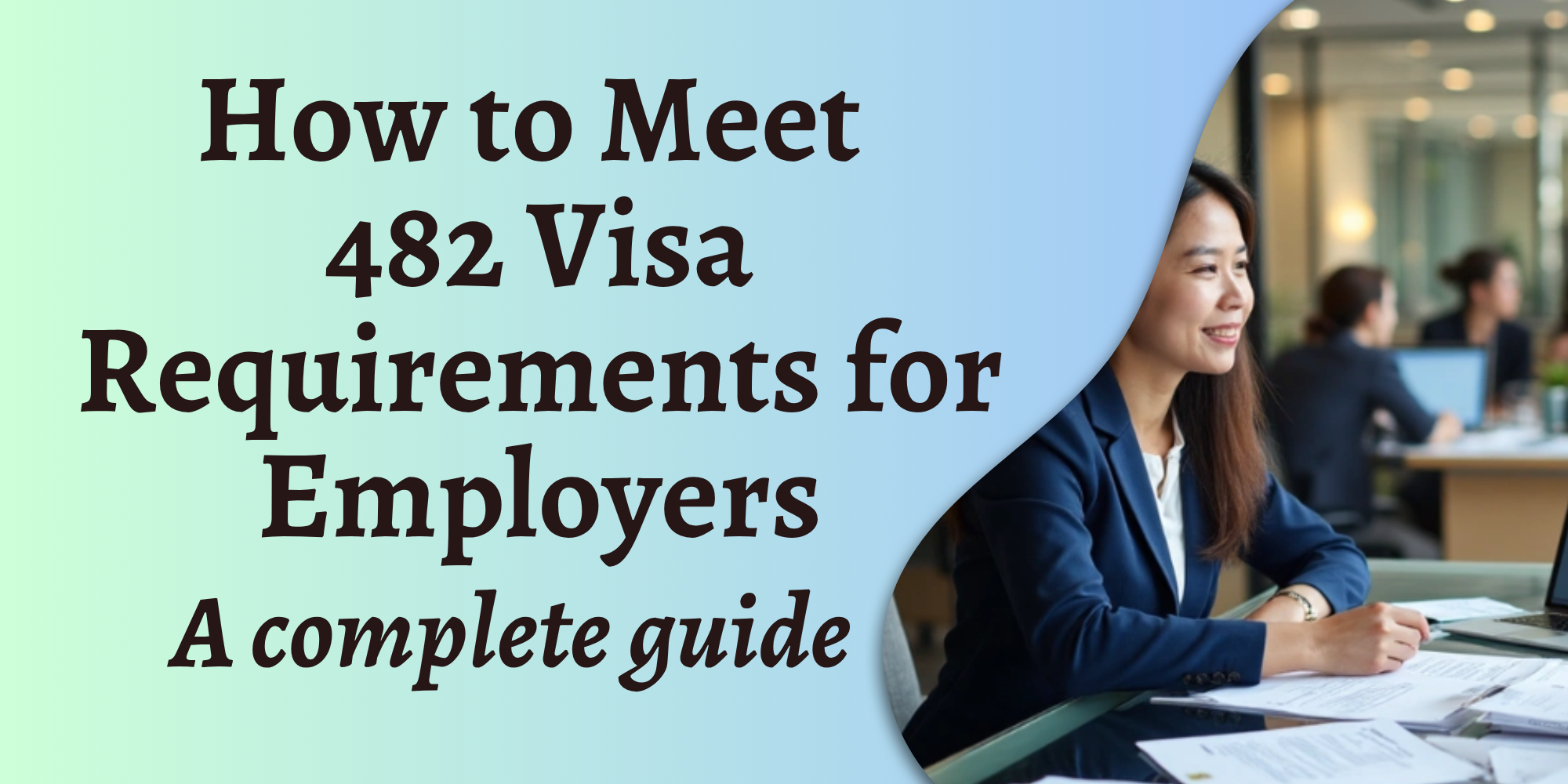The 482 visa opens doors to 456 occupations throughout Australia. That’s right – your business has more options than you might think.
Your company can sponsor overseas workers through this Temporary Skill Shortage visa for two to four years, based on the position. Most applications take about four weeks to process, but the requirements need careful attention to avoid complications.
The sponsorship process requires you to show your support for local hiring, pay the Skilling Australians Fund levy, and ensure your job opening matches the government’s skills lists. You’ll also need to complete Labour Market Testing to show that no qualified Australian citizens or permanent residents can fill the role.
Does this sound complex? We’ve got you covered. This piece simplifies the 482 visa sponsorship into four clear steps. You’ll learn everything from becoming a Standard Business Sponsor to managing your ongoing responsibilities. Let’s make your sponsorship process straightforward and effective.
Step 1: Become a Standard Business Sponsor
Standard Business Sponsorship (SBS) serves as a vital first step to meet 482 visa requirements. This process helps determine if your business qualifies to sponsor skilled workers from overseas.
What is a standard business sponsor?
The Department of Home Affairs assesses and approves standard business sponsors to bring skilled overseas workers. Your approval lets you sponsor eligible candidates through Skills in Demand visa (subclass 482) or Skilled Employer Sponsored Regional (Provisional) visa (subclass 494). This status shows that your organisation meets government standards to sponsor foreign workers.
Five-year approval periods apply to businesses that are 12 months old or more. Businesses less than 12 months old receive sponsorship approval only for their first year.
Eligibility criteria for employers
Your business must meet these requirements to qualify as a standard business sponsor:
- Legal establishment and active operations in Australia or overseas
- No adverse information about your entity or associated persons (unless reasonably disregarded)
- Lawful business operations with clean background
- Direct employment of sponsored employees (exemptions may apply)
Australian businesses must also show:
- Strong track record of hiring local workers (or commitment to do so)
- Fair employment practises without discrimination
Businesses of all types can apply for standard business sponsorship. This includes sole traders, partnerships, proprietary companies, public companies, government departments, statutory authorities, non-profits, and educational institutions.
Documents needed for SBS approval
The right documentation plays a significant role in your SBS application. Australian businesses should provide:
- ABN history statement with correct legal name
- ASIC history statement with ACN registration (if applicable)
- Certificate of Incorporation (incorporated associations)
- Trust deed relevant pages (trustee operations)
Your business must prove active operations through:
- Audited balance sheets and profit/loss statements
- Recent quarters’ Business Activity Statements (BAS)
- Business tax returns
- Business premises lease agreements
- Staff employment records
- Annual reports
New businesses under 12 months can submit bank statements from their operation period, sales contracts, equipment leases, or an accountant’s support letter.
The process requires you to submit your application through ImmiAccount with a sponsorship fee of AUD 642.18.

Step 2: Nominate a Genuine Position
The next significant step after getting your Standard Business Sponsor status involves nominating a genuine position that meets Department of Home Affairs requirements. This stage needs careful preparation and attention to detail.
Understanding the ANZSCO occupation list
The Australian and New Zealand Standard Classification of Occupations (ANZSCO) serves as the foundation of the 482 visa occupation framework. Your nominated position must appear on the Core Skills Occupation List (CSOL), which has 456 different occupations. The Department relies on the 2022 version of ANZSCO specifically for the Skills in Demand visa (subclass 482).
Your selected occupation code should line up with the position’s duties and responsibilities. The role should reflect real responsibilities—neither too broad nor an exact replica of the ANZSCO description. Case officers look for this balance while reviewing your application.
Labour Market Testing (LMT) explained
Labour Market Testing shows you couldn’t find suitable Australian workers for the position. Since December 2023, employers just need two valid advertisements instead of three. These advertisements should:
- Run for at least four weeks within four months before lodging
- Be published in English on prominent recruitment websites with national reach
- Show the position title, required skills, sponsor/recruiter name, and salary (if under AUD 147,394.66)
Citizens from China, Japan, Mexico, the UK, Singapore, and other countries might qualify for exemptions under international trade obligations.
How to prove the position is genuine
The Department takes a close look at nominations to ensure positions aren’t created just for migration. A genuine position should show:
- The position fits your business scope and scale
- The role matches your regular business activities
- The business need for this role (expansion, staff resignation)
- Previous people in the role (if applicable)
- Clear recruitment processes
You might face extra scrutiny if your business has laid off employees within 12 months, cut Australian workers’ hours or conditions, or hired temporary visa holders beyond normal business operations.
The nomination process works best when you tell a compelling story about why this position exists and needs overseas talent. This could be because of business growth, technical skills gaps, or challenges finding qualified local candidates.
Step 3: Support the Employee’s Visa Application
Your next responsibility after nominating a position is to support your employee through their visa application process. The Department of Home Affairs will approve their 482 visa only when applicants meet all eligibility criteria.
Minimum work experience and skills
The skilled worker you sponsor must prove they have relevant qualifications and experience that match their nominated occupation. Your employee needs:
- At least two years of full-time work experience in the nominated or closely related occupation
- Formal qualifications that match Australian standards (may require skills assessment)
- A genuine intention to perform the nominated role
You should verify these credentials carefully before moving forward with sponsorship. Review their employment references, qualification certificates, and required skills assessments. False documentation can lead to visa refusal and potential sponsorship penalties.
English language and health requirements
Your sponsored employee must reach specific English language standards unless they qualify for exemption. Most applicants need to achieve:
- An IELTS overall score of 5.0 (with no band below 4.5), or
- Equivalent scores in accepted alternatives like TOEFL, PTE, or CAE
Health examinations are mandatory for all applicants. These include chest x-rays and medical assessments by Department-approved medical practitioners. You should encourage employees to schedule these assessments right after submitting their application.
Visa conditions employers must understand
You need to know the essential visa conditions that impact both you and your employee:
- Sponsored workers can only work in their nominated occupation for your business
- The worker must maintain health insurance coverage throughout their stay
- You must report any changes to employment conditions to the Department
- The employee cannot cease employment with you for more than 60 consecutive days
Different occupations qualify for different visa periods, which is crucial to understand. Short-term stream occupations allow stays up to 2 years, while medium/long-term stream occupations permit up to 4 years. Your business planning should factor in these timeframes from the start.
Step 4: Meet Ongoing Employer Obligations
Your 482 visa sponsor duties don’t end after getting approval. You need to meet ongoing requirements to keep your sponsorship status and avoid heavy penalties.
Paying the market salary and SAF levy
Sponsored employees must receive at least the Annual Market Salary Rate (AMSR), which matches an Australian worker’s pay in the same role. The salary needs to stay above the Temporary Skilled Migration Income Threshold (TSMIT). This threshold sits at AUD 73,150 for applications between July 2024 and June 2025.
The Skilling Australians Fund (SAF) levy requires mandatory payment with nomination applications:
- Small businesses (annual turnover less than AUD 15.29 million): AUD 1,200 per year
- Larger businesses: AUD 1,800 per year
You can’t pass these costs to visa holders. The levy offers tax deductions but refunds only apply in specific cases, like visa rejections based on health or character grounds.
Record-keeping and reporting duties
Your business needs detailed records to prove compliance with sponsorship obligations. Keep these records in a reproducible format:
- Employment contracts and salary details
- Tasks performed by the employee in their nominated occupation
- Payment records, including non-monetary benefits
- Any notifications made to the Department
The Department needs to know within 28 calendar days if employment ends. Report any changes to employment terms or contact details too.
Record-keeping requirements last for two years after your sponsorship ends or you stop employing sponsored workers.
What happens if you breach sponsorship rules
Breaking sponsorship rules brings serious penalties. The Department of Home Affairs can:
- Cancel your sponsorship approval
- Stop you from sponsoring more visa holders
- Issue civil penalties up to AUD 605,480 for corporations and AUD 116,509 if you have a small business
- Give infringement notices up to AUD 121,096 for corporations and AUD 24,219 for individuals
The Department might order compliance notices or demand enforceable undertakings to fix breaches. Major violations could land your business on the Public Register of Sanctioned Sponsors.
Conclusion
The 482 visa sponsorship process demands close attention to detail across all four steps. Your first step to become a Standard Business Sponsor builds the eligibility foundation. The next step shows your genuine need for overseas talent through position nomination. You must then help your employee meet all qualification and language requirements in their visa application.
Your duties as a sponsor do not end with visa approval. You must pay proper salary rates, handle the SAF levy, and meet record-keeping rules throughout the sponsorship period. The penalties for breaking these rules are severe. Corporations face fines of over AUD 600,000 or complete sponsorship cancellation.
The process might seem complex, but sponsoring skilled overseas workers brings great value to businesses that face real skills shortages. The 482 visa programme lets you tap into global talent pools when qualified Australian workers are not available.
This piece breaks down what can be an overwhelming process into simple steps. The requirements might look tough at first, but they become manageable when broken into steps. Professional migration advice can help you handle complex situations or answer specific questions about your case. Good planning and focus on compliance will help your business direct the 482 visa sponsorship process and find the skilled workers you need.

